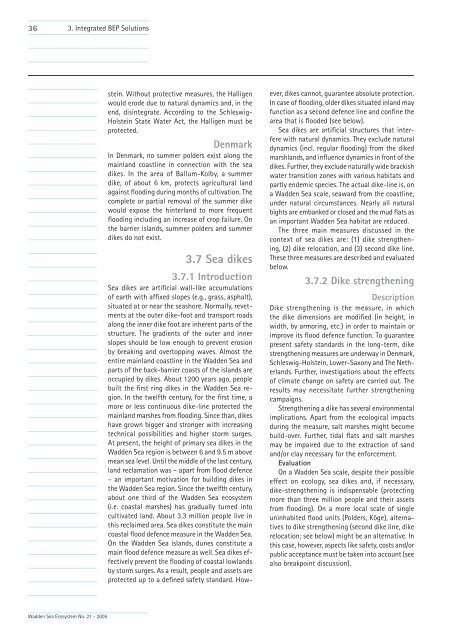Coastal Protection and Sea Level Rise - Hochwasser
Coastal Protection and Sea Level Rise - Hochwasser
Coastal Protection and Sea Level Rise - Hochwasser
You also want an ePaper? Increase the reach of your titles
YUMPU automatically turns print PDFs into web optimized ePapers that Google loves.
36<br />
3. Integrated BEP Solutions<br />
stein. Without protective measures, the Halligen<br />
would erode due to natural dynamics <strong>and</strong>, in the<br />
end, disintegrate. According to the Schleswig-<br />
Holstein State Water Act, the Halligen must be<br />
protected.<br />
Denmark<br />
In Denmark, no summer polders exist along the<br />
mainl<strong>and</strong> coastline in connection with the sea<br />
dikes. In the area of Ballum-Kolby, a summer<br />
dike, of about 6 km, protects agricultural l<strong>and</strong><br />
against flooding during months of cultivation. The<br />
complete or partial removal of the summer dike<br />
would expose the hinterl<strong>and</strong> to more frequent<br />
flooding including an increase of crop failure. On<br />
the barrier isl<strong>and</strong>s, summer polders <strong>and</strong> summer<br />
dikes do not exist.<br />
3.7 <strong>Sea</strong> dikes<br />
3.7.1 Introduction<br />
<strong>Sea</strong> dikes are artificial wall-like accumulations<br />
of earth with affixed slopes (e.g., grass, asphalt),<br />
situated at or near the seashore. Normally, revetments<br />
at the outer dike-foot <strong>and</strong> transport roads<br />
along the inner dike foot are inherent parts of the<br />
structure. The gradients of the outer <strong>and</strong> inner<br />
slopes should be low enough to prevent erosion<br />
by breaking <strong>and</strong> overtopping waves. Almost the<br />
entire mainl<strong>and</strong> coastline in the Wadden <strong>Sea</strong> <strong>and</strong><br />
parts of the back-barrier coasts of the isl<strong>and</strong>s are<br />
occupied by dikes. About 1200 years ago, people<br />
built the first ring dikes in the Wadden <strong>Sea</strong> region.<br />
In the twelfth century, for the first time, a<br />
more or less continuous dike-line protected the<br />
mainl<strong>and</strong> marshes from flooding. Since than, dikes<br />
have grown bigger <strong>and</strong> stronger with increasing<br />
technical possibilities <strong>and</strong> higher storm surges.<br />
At present, the height of primary sea dikes in the<br />
Wadden <strong>Sea</strong> region is between 6 <strong>and</strong> 9.5 m above<br />
mean sea level. Until the middle of the last century,<br />
l<strong>and</strong> reclamation was – apart from flood defence<br />
– an important motivation for building dikes in<br />
the Wadden <strong>Sea</strong> region. Since the twelfth century,<br />
about one third of the Wadden <strong>Sea</strong> ecosystem<br />
(i.e. coastal marshes) has gradually turned into<br />
cultivated l<strong>and</strong>. About 3.3 million people live in<br />
this reclaimed area. <strong>Sea</strong> dikes constitute the main<br />
coastal flood defence measure in the Wadden <strong>Sea</strong>.<br />
On the Wadden <strong>Sea</strong> isl<strong>and</strong>s, dunes constitute a<br />
main flood defence measure as well. <strong>Sea</strong> dikes effectively<br />
prevent the flooding of coastal lowl<strong>and</strong>s<br />
by storm surges. As a result, people <strong>and</strong> assets are<br />
protected up to a defined safety st<strong>and</strong>ard. However,<br />
dikes cannot, guarantee absolute protection.<br />
In case of flooding, older dikes situated inl<strong>and</strong> may<br />
function as a second defence line <strong>and</strong> confine the<br />
area that is flooded (see below).<br />
<strong>Sea</strong> dikes are artificial structures that interfere<br />
with natural dynamics. They exclude natural<br />
dynamics (incl. regular flooding) from the diked<br />
marshl<strong>and</strong>s, <strong>and</strong> influence dynamics in front of the<br />
dikes. Further, they exclude naturally wide brackish<br />
water transition zones with various habitats <strong>and</strong><br />
partly endemic species. The actual dike-line is, on<br />
a Wadden <strong>Sea</strong> scale, seaward from the coastline,<br />
under natural circumstances. Nearly all natural<br />
bights are embanked or closed <strong>and</strong> the mud flats as<br />
an important Wadden <strong>Sea</strong> habitat are reduced.<br />
The three main measures discussed in the<br />
context of sea dikes are: (1) dike strengthening,<br />
(2) dike relocation, <strong>and</strong> (3) second dike line.<br />
These three measures are described <strong>and</strong> evaluated<br />
below.<br />
3.7.2 Dike strengthening<br />
Description<br />
Dike strengthening is the measure, in which<br />
the dike dimensions are modified (in height, in<br />
width, by armoring, etc.) in order to maintain or<br />
improve its flood defence function. To guarantee<br />
present safety st<strong>and</strong>ards in the long-term, dike<br />
strengthening measures are underway in Denmark,<br />
Schleswig-Holstein, Lower-Saxony <strong>and</strong> The Netherl<strong>and</strong>s.<br />
Further, investigations about the effects<br />
of climate change on safety are carried out. The<br />
results may necessitate further strengthening<br />
campaigns.<br />
Strengthening a dike has several environmental<br />
implications. Apart from the ecological impacts<br />
during the measure, salt marshes might become<br />
build-over. Further, tidal flats <strong>and</strong> salt marshes<br />
may be impaired due to the extraction of s<strong>and</strong><br />
<strong>and</strong>/or clay necessary for the enforcement.<br />
Evaluation<br />
On a Wadden <strong>Sea</strong> scale, despite their possible<br />
effect on ecology, sea dikes <strong>and</strong>, if necessary,<br />
dike-strengthening is indispensable (protecting<br />
more than three million people <strong>and</strong> their assets<br />
from flooding). On a more local scale of single<br />
uninhabited flood units (Polders, Köge), alternatives<br />
to dike strengthening (second dike line, dike<br />
relocation; see below) might be an alternative. In<br />
this case, however, aspects like safety, costs <strong>and</strong>/or<br />
public acceptance must be taken into account (see<br />
also breakpoint discussion).<br />
Wadden <strong>Sea</strong> Ecosystem No. 21 - 2005




